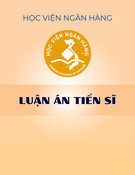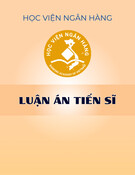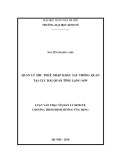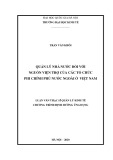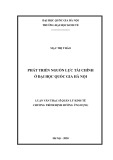
MINISTRY OF TRAINING AND EDUCATION
VINH UNIVERSITY
¯¯¯¯¯¯¯¯¯¯¯¯¯¯¯
PHAN THI CHAU
POLITICAL AND ECONOMIC RELATIONS
BETWEEN INDIA AND MYANMAR FROM 1991 TO 2017
SUMMARY OF THE DOCTORAL THESIS OF HISTORY
NGHE AN, 2020

THE THESIS WAS COMPLETED AT VINH UNIVERSITY
Scientific Supervisors:
1. ASSOC. PROF. DR. VAN NGOC THANH
2. DR. LE THE CUONG
Examiner 1:
Examiner 2:
Examiner 3:
The thesis is defended before the Ph.D. Thesis Evaluation Council
at the University level in Vinh University.
Time: ......h...... dated ...../...../........
This thesis is available for the purpose of reference at:
- National Library of Vietnam;
- Center of Nguyen Thuc Hao Library, Vinh University.

1
Introduction
1. Rationale
India and Myanmar are two neighboring countries that have a long-standing
cultural, historical and ethnic relationship, have a long land and sea border in the
Bengal Bay, it is of strategic importance to the entire East - South Asia region.
Myanmar is a country in Southeast Asia but it has a border with both major countries
that are India and China, lying on the important road towards the east of India, and
the road towards the Indian Ocean of China. Because of that, the history of this
country has been deeply influenced by the strategic competition of major countries.
Seeing the India - Myanmar relationship in the perspective of a relationship with a
long history and culture, but as an asymmetric relationship between a large country
and a small country, interwoven various beneficial factors has attracted the attention
of many researchers on the history of international relations.
The relationship of India and Myanmar was officially established when the
Friendship Treaty was signed in 1951. By 1991, after 40 years, the India-Myanmar
relationship, despite experiencing many ups and downs, also left many marks in the
development of two countries. The study of the India-Myanmar relationship from
1991 to 2017 aims to further delve deeper into a traditional neighborly relationship,
between a large country and a small country, clearly reflecting the mix of national
interests and human rights democratic values ... have profound scientific and practical
significance.
India's policy towards Myanmar has undergone radical changes since the coup
and the establishment of the military regime in Myanmar on 08 August 1988. India,
along with Western countries, condemned the military regime and implemented an
embargo against Myanmar. The socio-political situation in Myanmar was always
unstable, the closed policy along with the US and Western embargo and sanctions
made Myanmar separate from the world, even when Myanmar was recognized as a
member of ASEAN in 1997. Since 2003, Myanmar has entered the democratic
reform process according to the 7-Step Roadmap and initially achieved positive
results. The international community had begun to turn to support Myanmar, creating
a strategic competition between the major countries in this country. The study of the
India-Myanmar relationship in the context of sweeping changes in Myanmar and
India's policy as a regional power towards Myanmar had profound scientific
implications.
China's increasing influence in Myanmar, especially after 1988, created strategic
concern for India. Therefore, the Indian Government over the periods had made step-

2
by-step efforts to change policy with Myanmar after 1991, building a comprehensive
relationship with Myanmar, including politics and economy. For Myanmar, the
process of democratic reform and national development needed the support of a big
neighboring country as important as India. The growing dependence on China
required Myanmar's rulers to seek a balance in their relations with major countries.
Researching this relationship on the political and economic fields to understand the
nature and the need for benefits from both India and Myanmar, in the context of
China's unpeaceful rise was essential.
Since 1991, India has shifted its foreign policy toward new strategic
considerations with a focus on Look East Policy, followed by Act East. Myanmar is a
strategically important neighbor on the road towards the East of India. As a member
of ASEAN in 1997 and joining into the most of regional cooperation mechanisms,
Myanmar has become a gateway country on the road to Southeast Asia and Asia -
Pacific Ocean - a region of most dynamically development in the world in the
twenty-first century of India. Study about this relationship from 1991 to 2017 in order
to better understand the manifestation of India's Look East/Act East Policy on a
particular country.
On the other hand, Myanmar shares borders with the sensitive northeastern
states of India. Myanmar has a border with China and India, creating an unstable T-
junction in politics and security. The relationship between two countries has always
had potential instability factors for many years related to reactionary political forces,
border disputes, drug crimes ... Research on the India-Myanmar relationship aims to
shed light on the development of bilateral relations and how to resolve disagreements
to develop with high scientific and practical significance. On that basis, studying the
relationship between India and Myanmar from 1991 to 2017 in order to draw
evocative lessons for Vietnam in the relationship among major countries.
Stemming from the above reasons, we choose the research topic of the thesis as
“Political and economic relations between India and Myanmar from 1991 to 2017”.
2. Subject, objects of research
2.1. Subject of research
The thesis systematically and objectively reproduces on the process of political
and economic relations between India and Myanmar in the period 1991 - 2017,
thereby drawing out the characteristics of this relationship.
2.2. Objects of research
Time: The thesis focuses on research: “Political and economic relations
between India and Myanmar from 1991 to 2017”, that was, since India adjusted its
foreign policy, including the Look East Policy and the initial change in policy

3
towards Myanmar; Indian Prime Minister Narendra Modi's visiting to Myanmar in
September 2017 marked a strong shift in the bilateral relationship in many fields.
Space: The research space of the thesis is mainly two subjects: India and
Myanmar. However, because the political and economic relations of India - Myanmar
in the period 1991 - 2017 were also influenced by other subjects, so the research
space mentioned was the Asian - Pacific Ocean regional context (understood in a
broad sense including Asian countries and Pacific coastal countries).
Contents: The thesis researches on India - Myanmar relations from 1991 to
2017, in which mainly focuses on the research of bilateral relations on the main fields
of politics (diplomatic politics, national security politics) and economics (focusing on
two main areas: trade in goods, investment). Relations between two countries in
multilateral forums and relations in other fields such as society, culture ... are
mentioned under the perspective of reference in order to clarify the tasks that the
thesis seted out.
Regarding the use of the name "Myanmar" in the thesis: In 1989, the ruling
Military Council changed the country name in English from "Burma" into
"Myanmar". This change is still not accepted by many groups of Myanmar people
because they do not accept the legitimacy of the military government. The United
States, Australia, Ireland and Great Britain continue to use the name "Burma", while
the European Union uses both. The United Nations uses the name "Myanmar". In
order to ensure consistency, not to have political significance in using the name, the
thesis will use the official name as Myanmar in the text. The term of “Burma” will
only be written in certain historical contexts prior to 1988 or in citations.
In addition to the research object, limitations of time, space, contents mentioned
above, other issues are not within the scope of the thesis research.
3. Objectives and task of research
3.1. Objectives of research
The thesis is done to clarify the changes in India - Myanmar relations in the
political and economic fields from 1991 to 2017. On that basis, the thesis analyzes
the impact of this relationship for each country, region and draw features of the India-
Myanmar relationship during this period.
3.2. Task of research
The thesis defines the task:
- Analysis of factors affecting India - Myanmar relations from 1991 to 2017.
- Comprehensive and systematic rehabilitation of the India-Myanmar political
and economic relations from 1991 to 2017.
- Draw comments on the characteristics of the bilateral relationship and its



